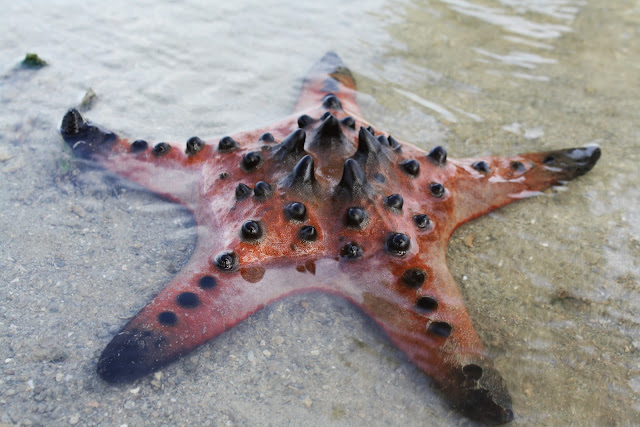
Protoreaster nodosus (Knobbly sea star)
| Scientific classification | |
|---|---|
| Kingdom: | Animalia |
| Phylum: | Echinodermata |
| Class: | Asteroidea |
| Order: | Valvatida |
| Family: | Oreasteridae |
| Genus: | Protoreaster |
| Species: | P. nodosus |
| Binomial name | |
| Protoreaster nodosus (Linnaeus, 1758) | |
This huge and colourful sea star is sometimes seen on Chek Jawa and some of our undisturbed Northern and Southern Shores. Adults are usually seen in coral rubble areas, alone or widely spaced apart. Juveniles are commonly seen on Cyrene Reef among seagrasses. These spectacular animals are the highlight of a shore trip!
Features: Diameter with arms, adults to 30cm, juveniles 8-15cm. Hard, heavy body that is calcified. Arms long tapering to rounded tip, thick and triangular in cross-section. Although their arms appear stiff, these can bend quite extensively. When submerged tiny transparent finger-like structures (papulae) might be seen on the upperside. This species is generally identified by the single row of knobs along the upperside of the arms. The shape, colour and number of knobs may vary. Underneath, from grooves under the arms, emerge tube feet with sucker-shaped tips. These tube feet can be bright red or purple! Knobbly sea stars are mostly red, orange or brown, but sometimes white or pink ones are encountered. Blue or green ones are also sometimes seen.
Knobbly sea stars are not venomous, although they are often brightly coloured and covered with dangerous-looking knobs, nodules and spines. They are also called the Giant Nodulated sea star, Horned sea star or Chocolate Chip sea star.
What do they eat?
Features: Diameter with arms, adults to 30cm, juveniles 8-15cm. Hard, heavy body that is calcified. Arms long tapering to rounded tip, thick and triangular in cross-section. Although their arms appear stiff, these can bend quite extensively. When submerged tiny transparent finger-like structures (papulae) might be seen on the upperside. This species is generally identified by the single row of knobs along the upperside of the arms. The shape, colour and number of knobs may vary. Underneath, from grooves under the arms, emerge tube feet with sucker-shaped tips. These tube feet can be bright red or purple! Knobbly sea stars are mostly red, orange or brown, but sometimes white or pink ones are encountered. Blue or green ones are also sometimes seen.
Knobbly sea stars are not venomous, although they are often brightly coloured and covered with dangerous-looking knobs, nodules and spines. They are also called the Giant Nodulated sea star, Horned sea star or Chocolate Chip sea star.
What do they eat?
According to Lane, it eats micro-organisms and scavenges on dead creatures. According to Gosliner, it probably feeds on sponges. According to Schoppe, it prefers to eat clams and snails but also eats sponges, soft corals and other invertebrates.
According to Coleman the sea star hosts shrimps, scale worms, harlequin crabs and sea star crabs. Others report parasitic snails as well as. But these have not been observed on the Knobbly sea stars seen at low tide.
Credit:http://www.wildsingapore.com/wildfacts/echinodermata/asteroidea/protoreaster.htm
According to Coleman the sea star hosts shrimps, scale worms, harlequin crabs and sea star crabs. Others report parasitic snails as well as. But these have not been observed on the Knobbly sea stars seen at low tide.




I would ask are there any starfish that only eat algae.
ReplyDelete